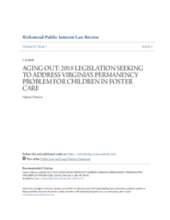Displaying 411 - 420 of 1787
This article outlines the arguments made in recent litigation undertaken by the Public Interest Advocacy Centre (PIAC) on behalf of young people who requested access to legal audits conducted on their files by the New South Wales (NSW) Department of Family and Community Services (FACS).
This systematic literature review examines how the construct of cumulative harm is understood and operationalized within current Australian child protection legislation, policy, and practice and situates this within an international context.
Drawing on national-level data from the United States' child protection system, this study examines the prevalence of substantiated child protection cases involving a parent with an intellectual disability as well as information about demographic characteristics, risk factors, child maltreatment types and services provided at the start of a child protection case.
In her report, the Special Rapporteur on the rights of persons with disabilities provides an overview of the activities undertaken in 2018 and a thematic study on disability-specific forms of deprivation of liberty, in the light of the standards set forth in the Convention on the Rights of Persons with Disabilities.
The current study explores how historical trauma has impacted American Indian tribes' trust in today's US public child welfare agencies.
Guided by social-ecological theory, this study explores responses to violence against children with disabilities, including preventative measures and treatment of victims in the West African countries of Guinea, Niger, Sierra Leone, and Togo.
This short human rights in action article takes a critical approach to the translation of policy to practice and highlights risks involved with haste, outcomes measured in numbers and unrealistic timeframes, and rapidly transforming practice with nascent investment in a country’s capacity to assess and respond to the real needs of children and families within their communities.
Information and Communications Technologies (ICT) are increasingly, and increasingly effectively, being used in development and humanitarian work. Whereas health and education lead this use, application to child protection remains sparse and ill-understood. This paper helps address these two gaps.
This analysis examines both historical and contemporary approaches to addressing religion and race in child welfare policy and practice, with a particular focus on adolescent youth.
This article by staff attorney for family law and child welfare at the Virginia Poverty Law Center's Center for Family Advocacy, Valerie L’Herrou, outlines and analyses several new bills introduced by the Virginia General Assembly in 2018 and their impacts on young people aging out of the foster care system and family reintegration.


